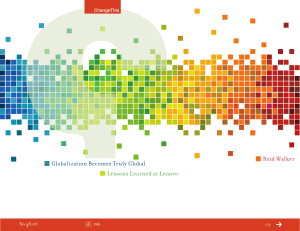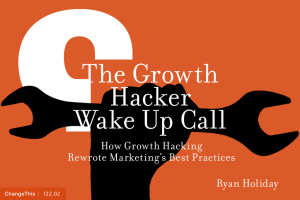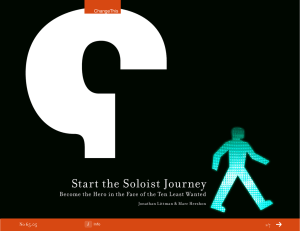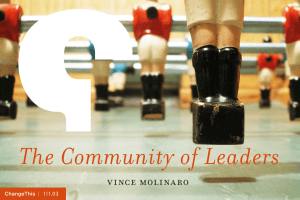Stop the busywork! 7 Counter-Intuitive Ways to Find More Michael Bungay Stanier
advertisement
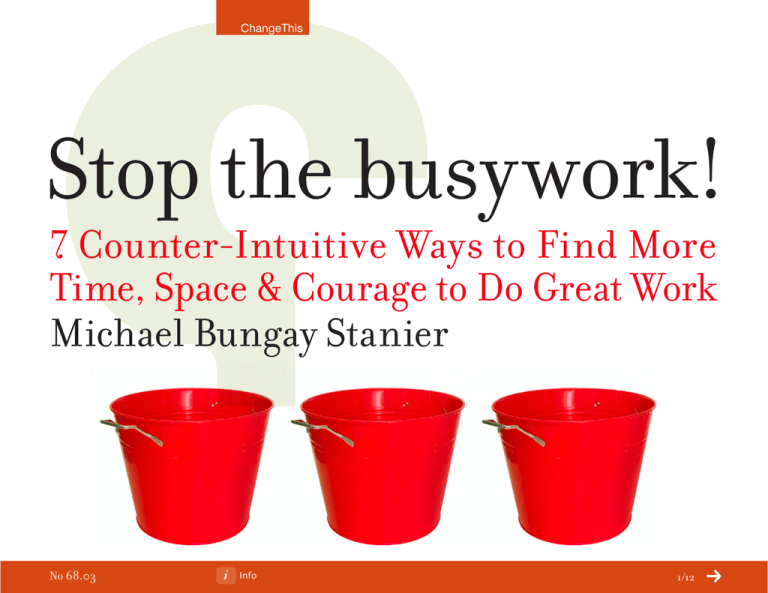
ChangeThis Stop the busywork! 7 Counter-Intuitive Ways to Find More Time, Space & Courage to Do Great Work Michael Bungay Stanier No 68.03 Info 1/12 ChangeThis Are You Busy? Don’t worry—it’s a rhetorical question. Of course you are. The days of whiling away the hours playing Tetris at work are long gone. With organizations that are lean, global and matrixed, with nowhere to hide from emails and meetings, everyone’s busier than ever before. But it’s not a good busy. It can be, sure. But most of us have found that the goal of our current working lives is simply to get through the stuff. To process the inbox, attend the meetings and end up at the end of the week a little further ahead rather than further behind. The problem is the busywork, and it’s got to stop. You’ve already heard all the obvious strategies on how to manage “the overwhelm.” So here are 7 counter-intuitive, but practical ways you can stop the busywork. But, before we go there, let’s talk about why you should bother. No 68.03 Info 2/12 ChangeThis Three Types of Work Imagine everything you do could fall into one of three buckets: Bad Work. Good Work. Great Work. I’m not talking about the quality of the work you deliver—I’ve no doubt that’s fine. I’m talking about the meaning the work has for you and the impact it makes. Let me explain. Bad Work is the work that makes no difference, yet consumes your time and energy. Or, more bluntly, it’s those soul-sucking activities that make you question how you ever ended up spending precious moments of your life on anything like this. Endless meetings. Paperwork. Busywork. The bad news is that nearly every organization generates Bad Work. As we try to manage the complexities of working together through rules and structures and meetings, bureaucracy blossoms. Good Work is most likely the work you do most of the time, and you do it well. It’s necessary stuff that moves things along and gets things done. Organizations are primarily set up to do Good Work: create a product or service, do it efficiently, sell it to the world. There’s nothing wrong with Good Work—except for two things. First of all, it’s endless. Trying to get your Good Work done can feel like Sisyphus rolling his rock up the mountain, a never-ending task. And second, Good Work is comfortable. The routine and busy-ness of it all is seductive. You know in your heart of hearts that you’re no longer stretching No 68.03 Info 3/12 ChangeThis yourself or challenging how things are done. Your job has turned into just getting through your workload—week in, week out. Here’s a quick test. Ever get to the end of the week and—even though you’ve put in 40 or 50 or 60 hours—find yourself unable to remember much of what you actually did? That’s your brain saying, “there’s not much here that’s new,” and it’s a sign of too much Good Work. And then there’s Great Work. Great Work is what you were hoping for when you signed up for this job. It’s meaningful and it’s challenging. It’s about making a difference. It matters to you and it lights you up. It matters at an organizational level too. Great Work is at the heart of blue ocean strategy, of innovation and strategic differentiation, of evolution and change. Great Work sets up an organization for longer-term success. The challenge is that Great Work carries with it uncertainty and risk as well as impact and reward. We’re pulled towards what Great Work promises and pushed away by its threat. We want to free ourselves from the regularity and comfortable rut that is Good Work, and yet we’re tugged back by the familiarity and certainty that it provides. Most of us have found that the goal of our current working lives is simply to get through the stuff. No 68.03 Info 4/12 ChangeThis Why Don’t You Do More Great Work? When I ask people who work for organizations how much of each type of work they do— whether they work on the front-line or at the very top of the organization—here’s what I hear: 0% - 40% on Bad Work. 40% - 80% on Good Work. 0% - 25% on Great Work. Regardless of the numbers (and probably more important), no one has yet said to me, “I’ve got too much Great Work. I’m overloaded with meaningful, engaging work that really makes a difference.” So why aren’t we doing more Great Work? Why does life at work feel like a conveyor belt, churning through tasks, trying to just make it to the weekend—when, let’s face it, we’ll most likely open up the laptop “just to stay on top of our email?” The problem is the busywork, and it’s got to stop. No 68.03 Info 5/12 ChangeThis Count Down How many days do you have left? It’s a sobering exercise, and one that you can calculate with some statistical certainty. If you’re a North American, 40 year old man, you’ve got about 13,500 days (that takes you to the end of 2046). A 40 year old woman? 15,000, or to early 2051. If you’re a 50 year old man, it’s closer to 10,000 (that’s the middle of 2037) while a woman the same age has 11,500 days (till the end of 2041). As I write this, I’ve got 12,298 days left, which makes my Big Day September 15, 2043. In case it’s not obvious, the point is this: Time. Is. Ticking. You either get to spend your time between now and then keeping busy, or you can decide to do more Great Work—more of the work that makes you happy and makes a difference to others. So, let’s see how you might do just that. 1 | Abandon your job description. Your job description is the perfect prescription for, and description of, Good Work. It sets out a long list of expectations and on-going tasks that roll on and on for the life of the job. It might have made sense on day one, but things have changed since then and it’s no longer good enough. Turn everything you do into a project. A project has a beginning, middle and an end. A job description is a never-ending Mobius strip. A project has an outcome you’re striving for. A job description has no end in sight. A project carries with it the opportunity of Great Work. A job description carries with it the assumption of Good Work. No 68.03 Info 6/12 ChangeThis There’s a reason why Google has made everything project-based. You’re the sum of the projects you’re working on. 2 | One plus two: define your “gravy tasks.” It’s not much of a measure of success to tick off 47 “to do’s” in a day if you haven’t actually accomplished what matters most. Busy-ness does not equate with success. Start each day by defining one—just one—high impact action that you will definitely, certainly complete. Put it as an “all day task” on your calendar, so it stays at the top of your mind. Then define two bonus, high-impact tasks. I call these my “gravy tasks”—great if you get to them, but not a stick to beat yourself up with if you don’t. At the start of each day, check back on yesterday’s list, check them off if you can and define the 1+2 for today. Bolder still, share your lists—how you did yesterday, what you plan on doing today—with a friend, team-member or colleague. That accountability will have a significant impact on you getting done what you want to do. 3 | Say yes—slowly. Much has been written about the importance of being able to say “no,” and it’s very true. Until you learn how to say no, stuff will keep rolling down the hill and end up on your plate. But, the truth is, it’s difficult to say no in most organizations. We’re all nice, polite people. We’ve got it into our heads that success lays in saying yes. (And, ideally, with enthusiasm!) Surely it’s a careerlimiting move to get a reputation as being someone who says no? So, don’t say no. No 68.03 Info 7/12 ChangeThis Rather, master the art of saying yes slowly. Rather than making yes your default response, ask some questions—I’d suggest at least three—before you make a decision. Here are some for a starter: Why are you asking me? Who else have you considered for this? What exactly would I need to do? When you say “urgent,” what does that mean? If I could only do part of this, what part would I do? How does this fit with my current project load? How does this fit with our weekly/monthly/annual goals? 4 | Create a Great Work space. When you sit down at your desk at the start of the day and crank up your computer, you set your body and brain into Good Work mode: be productive, be efficient. Great Work requires a differently type of thinking. Find somewhere else to do your Great Work— another place in your office, another meeting room, the cafeteria, a coffee shop down the road. Your body leads your brain. Changing the context and changing the way your physical stance will change the way you work. Striving for excellence in all you do isn’t only overrated. It’s overwhelming and impossible. No 68.03 Info 8/12 ChangeThis 5 | Embrace adequate. Striving for excellence in all you do isn’t only overrated. It’s overwhelming and impossible. The standard you should be delivering in most of your work—the Good Work—is adequate. Just adequate. Only adequate. Now, don’t get me wrong. I’m not saying that you should be shoddy or do poor work. Adequate = sufficient. Adequate = good enough. Adequate = what’s required. Every time you over-invest in work that needs only be adequate, you’re creating your own busywork burden. Doing your Good Work at an adequate level means you have more time, energy and passion to put your attention to the Great Work. And the standard for that? Hugh MacLeod of GapingVoid said it best: “totally f*@cking amazing”. 6 | Only care about 8 people. The brutal truth is that if everyone is happy, then you’re probably not doing Great Work. Because Great Work involves making choices, you need to be very clear about who you want to say yes to—and who matters less. Thinking about your current projects, define your A-list (3 people) and your B-list (5 people) of who matters. These are your linchpins, those who have power and influence, whose opinion about you and your work you care about. Anyone not on the list, you can consider saying no to— or at the very least that slow yes. No 68.03 Info 9/12 ChangeThis 7 | McKinsey-fy your meetings. The consulting company McKinsey & Co are famous for weeding out the bottom 10% of performers in their organization every year. This “up or out” philosophy is harsh and ruthless—and effective. Apply the same approach to your meetings. Get clear on the most ineffective meetings you’re asked to attend—the ones where, quite frankly, no-one would really miss you if you weren’t there— and stop attending. If you have to keep your fingers in the pie, ask to be sent the list of actions instead. Or spend five minutes on the phone with someone getting the bottom-line summary of what happened. The brutal truth is that if everyone is happy, then you’re probably not doing Great Work. No 68.03 Info 10/12 ChangeThis Do More Great Work “You’ve got to find what you love. And that is as true for your work as it is for your lovers. Your work is going to fill a large part of your life, and the only way to be truly satisfied is to do what you believe is great work. And the only way to do great work is to love what you do. If you haven’t found it yet, keep looking. Don’t settle.” ~ Steve Jobs Don’t settle. That’s powerful guidance from Mr. Jobs. When you think about how you’re currently spending your time—your life—at work, how much of that is Great Work for you? Is it enough? Focus on who you are, what matters to you, and where the opportunities are around you. Have the courage to start something. Make it a Great Work project and take that first step… then the next. And be resilient. Get up when you fall down. Get back on the path when you wander off. Do more Great Work. No 68.03 Info 11/12 ChangeThis info About the Author Michael Bungay Stanier is the founder and Senior Partner of Box of Crayons, a company that helps organizations do less Good Work and more Great Work. He created The Eight Irresistible Principles of Fun, a short internet movie that has been viewed by millions of people around the world. His first book, Get Unstuck and Get Going... On the Stuff that Matters, has won a number of awards. Michael’s latest book is Do More Great Work: Stop the Busywork, and Start the Work That Matters. It contains 15 practical tools to help you find, start and sustain more Great Work. You can see a short, animated version of this manifesto at DoMoreGreatWork.com. buy the book Get more details or buy a copy of Michael Bungay Stanier’s Do More Great Work. send this Pass along a copy of this manifesto to others. Subscribe Sign up for our free e-newsletter to learn about our latest manifestos as soon as they are available. Born on date This document was created on March 3, 2010 and is based on the best information available at that time. Check here for updates. ABOUT CHANGETHIS Copyright info WHAT YOU CAN DO ChangeThis is a vehicle, not a publisher. We make it easy for big ideas to spread. While the authors we work with are responsible for their own work, they don’t necessarily agree with everything available in ChangeThis format. But you knew that already. The copyright of this work belongs to the author, who is solely responsible for the content. You are given the unlimited right to print this manifesto and to distribute it electronically (via email, your website, or any other means). You can print out pages and put them in your favorite coffee shop’s windows or your doctor’s waiting room. You can transcribe the author’s words onto the sidewalk, or you can hand out copies to everyone you meet. You may not alter this manifesto in any way, though, and you may not charge for it. ChangeThis is supported by the love and tender care of 800-CEO-READ. Visit us at 800-CEO-READ or at our daily blog. No 68.03 Info This work is licensed under the Creative Commons Attribution-NonCommercialNoDerivs License. To view a copy of this license, visit Creative Commons or send a letter to Creative Commons, 559 Nathan Abbott Way, Stanford, California 94305, USA. Cover photo from morgueFile. 12/12







